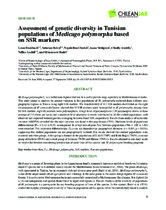Assessment of genetic diversity in Tunisian populations of Medicago polymorpha based on SSR markers

View/
Date
2021Author
Haddoudi, Loua
Hdira, Sabrine
Ludidi, Ndiko
Metadata
Show full item recordAbstract
Medicago polymorpha L. is a herbaceous legume that can be a useful pasture crop, especially in Mediterranean climates.
This study aimed to analyze the genetic variation in five populations of M. polymorpha collected from different ecogeographic regions in Tunisia using eight SSR markers. The transferability of 112 SSR markers distributed on the eight
chromosomes of M. truncatula Gaertn. showed that 50 SSR markers could be amplified in M. polymorpha. Among these
50 SSR markers, eight (8) markers were polymorphous. A high level of polymorphism (126 polymorphic alleles with an
average of 5.3 alleles per locus) and a moderate level of genetic diversity were found in all the studied populations, with
observed and expected heterozygosities averaging between 0 and 0.69, respectively. Results from analysis of molecular
variance (AMOVA) revealed that the most variation was found within populations (76%). Moderate levels of population
differentiation (FST = 0.12 to 0.19) accompanied by a high rate of gene flow between populations (Nm = 1.08 to 1.83)
were recorded. This molecular differentiation (FST) was not dependent on geographical distances (r = 0.395, p = 0.524),
suggesting that studied populations are not geographically isolated. Our results showed that studied populations were
clustered into three groups. A first group is formed by the populations of El Kef (TNP7) and Bulla Regia (TNP9), a second
group of Enfidha (TNP1) and a third group of Soliman (TNP8) and Mateur (TNP11). Results obtained in our study could
be helpful for breeders considering introduction of some lines of this species into M. polymorpha breeding programs.
